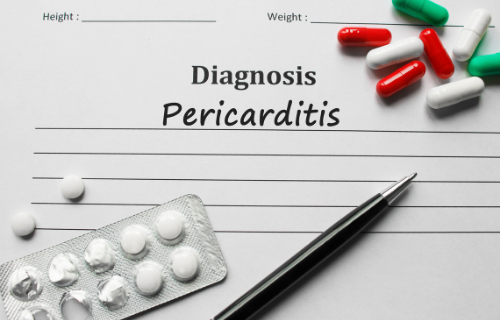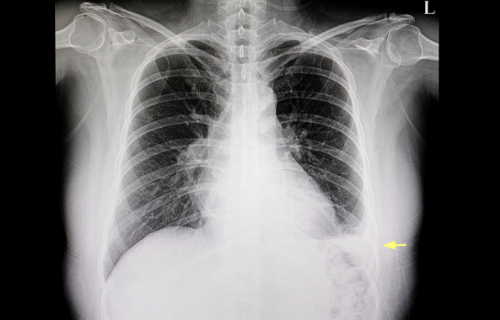Difference Between Pericarditis and Pericardial Effusion
Both pericarditis and pericardial effusion involve the pericardium. Pericarditis is inflammation of the pericardium while pericardial effusion occurs when there is excess fluid in the pericardium. The following discussions further delve into their differences.

What is Pericarditis?
Pericarditis or pericardial disease is inflammation of any of the layers of the pericardium, a thin tissue sac surrounding the heart (Beckerman, 2020).
Symptoms:
The most common symptom is sharp, piercing pain in the left side or center of the chest; the other symptoms may include heart palpitations, low fever, shortness of breath, fatigue, dry cough, nausea, and abdominal or leg swelling (Health Direct, 2021).
Causes/Risk:
One of the common reasons is viral infection; pericarditis may occur after a digestive or respiratory infection. Recurring and chronic pericarditis may be attributed to autoimmune disorders (the immune system makes antibodies that erroneously attack the body’s cells) like rheumatoid arthritis, lupus, and scleroderma.
The other possible causes include heart attack, heart surgery, kidney failure, AIDS, tuberculosis, cancer, injuries from radiation therapy or accidents, and side effects of certain medications (i.e., warfarin, heparin, and phenytoin).
Regarding risks, men ages 16 to 65 are more likely to develop pericarditis. Up to 30% of patients who were treated for acute pericarditis may experience it again (American Heart Association, 2021).
Treatment:
The treatments include medications (non-steroidal anti-inflammatory drugs, antibiotics, colchicine, and pain relief), avoiding strenuous activity, and surgery (American Heart Association, 2021). Most pericarditis patients recover in two to four weeks (Beckerman, 2020).

What is Pericardial Effusion?
Pericardial effusion occurs when there is excess fluid in the pericardium, a tough and double-layered saclike structure surrounding the heart. There are usually two to three tablespoons of clear yellow fluid that helps the heart move easier within the sac. However, an individual with pericardial effusion may have 100 ml to more than 2L of fluid between the sac’s two layers (Hoffman, 2020).
Symptoms
Those with mild effusion may not have symptoms; however, those with severe conditions may experience chest pain or discomfort, fainting, enlargement of neck veins, fast and short breathing, nausea, increased heart rate, swelling in the arms and legs, and pain in the right upper abdomen. Those with very severe effusion may experience very low blood pressure and show symptoms of shock such as dizziness, pale and clammy skin, rapid breathing, less urine output, nausea, vomiting, and cool arms and legs (Kang, & Wojcik 2021).
Causes
One of the most common causes is pericarditis, more fluid is produced due to the inflammation of the sac. The inflammation is usually caused by viral infections such as HIV, lupus, tuberculosis, echoviruses, cytomegalovirus, and coxsackieviruses. Other causes include cancer, heart injury due to medical procedure, heart attack, kidney failure, and autoimmune diseases. In many cases, a specific cause could not be found, and the condition may be called idiopathic pericardial effusion (Hoffman, 2020).
Treatment
The treatments may include medication (antibiotics and pain relievers), pericardiocentesis (draining the fluid), and surgery (Kang, & Wojcik 2021).
Difference between Pericarditis and Pericardial Effusion
Definition
Pericarditis or pericardial disease is inflammation of any of the layers of the pericardium, a thin tissue sac surrounding the heart (Beckerman, 2020). As for pericardial effusion, it occurs when there is excess fluid in the pericardium, a tough and double-layered saclike structure surrounding the heart (Hoffman, 2020).
Symptoms
The most common symptom of pericarditis is sharp, piercing pain in the left side or center of the chest; the other symptoms may include heart palpitations, low fever, shortness of breath, fatigue, dry cough, nausea, and abdominal or leg swelling (Health Direct, 2021). In comparison, those with mild effusion may not have symptoms; however, those with severe conditions may experience chest pain or discomfort, fainting, enlargement of neck veins, fast and short breathing, nausea, increased heart rate, swelling in the arms and legs, and pain in the right upper abdomen. Those with very severe effusion may experience very low blood pressure and show symptoms of shock such as dizziness, pale and clammy skin, rapid breathing, less urine output, nausea, vomiting, and cool arms and legs (Kang, & Wojcik 2021).
Causes
One of the common reasons of pericarditis is viral infection. Recurring and chronic pericarditis may be attributed to autoimmune disorders. The other possible causes include heart attack, heart surgery, kidney failure, AIDS, tuberculosis, cancer, injuries from radiation therapy or accidents, and side effects of certain medications (American Heart Association, 2021). Regarding pericardial effusion, one of the most common causes is pericarditis; the inflammation is usually caused by viral infections such as HIV, lupus, tuberculosis, echoviruses, cytomegalovirus, and coxsackieviruses. Other causes include cancer, heart injury due to medical procedure, heart attack, kidney failure, and autoimmune diseases. In many cases, a specific cause could not be found, and the condition may be called idiopathic pericardial effusion (Hoffman, 2020).
Treatment
The treatments for pericarditis include medications (non-steroidal anti-inflammatory drugs, antibiotics, colchicine, and pain relief), avoiding strenuous activity, and surgery (American Heart Association, 2021). Most pericarditis patients recover in two to four weeks (Beckerman, 2020). As for pericardial effusion, the treatments may include medication (antibiotics and pain relievers), pericardiocentesis (draining the fluid), and surgery (Kang, & Wojcik 2021).
Pericarditis vs Pericardial Effusion

Frequently Asked Questions (FAQs):
Can you have pericarditis without pericardial effusion?
Yes. Most patients with sudden onset pericarditis have only a small or no pericardial effusion (UpToDate, 2022).
How can you tell the difference between pleural effusion and pericardial effusion?
Pleural effusion is the buildup of fluid around the lungs; patients do not usually present with symptoms but those who do may experience shortness of breath, chest pain (especially when breathing in deeply), fever, and cough (Hoffman, 2020). On the other hand, pericardial effusion is the buildup of fluid around the heart; those with mild effusion may not have symptoms. Those with severe conditions may experience chest pain or discomfort, fainting, enlargement of neck veins, fast and short breathing, nausea, increased heart rate, swelling in the arms and legs, and pain in the right upper abdomen. Those with very severe effusion may experience very low blood pressure and show symptoms of shock such as dizziness, pale and clammy skin, rapid breathing, less urine output, nausea, vomiting, and cool arms and legs (Kang, & Wojcik 2021).
What is the most common cause of pericardial effusion?
One of the most common causes is pericarditis, more fluid is produced due to the inflammation of the sac. In many cases, a specific cause could not be found, and the condition may be called idiopathic pericardial effusion (Hoffman, 2020).
What is Beck’s triad used for?
Beck’s triad (low blood pressure, distension of jugular veins, and muffled heart sounds) is associated with the development of acute cardiac tamponade (a type of pericarditis) which occurs when the fluid buildup in the pericardial sac impairs the heart’s ability to pump well (Castillo, 2022).
What are the types of pericarditis?
The following are types of pericarditis according to symptoms and causes (Mestrovic, 2021)
| Types Based on Symptoms | Types Based on Causes |
| Acute (chest pain develops suddenly) | Constrictive (associated with thickening of pericardial layers which leads to the constriction of the heart) |
| Chronic (symptoms last longer than 3-6 mos.) | Pericardial Effusion (accumulation of fluid within the pericardial cavity) |
| Recurrent (repeated episodes) | Cardiac Tamponade (the increase of pericardial fluid leads to pericardium malfunction) |
| Viral (due to viruses such as coxsackieviruses, influenza virus, and HIV) | |
| Purulent (due to aerobic and anaerobic bacteria) | |
| Tuberculous (seen in a very minor percentage of those with pulmonary tuberculosis) | |
| Radiation (due to recent mediastinal radiation) | |
| Traumatic (due to sharp or blunt trauma) | |
| Malignancy (caused by metastatic disease) |
Summary
- Pericarditis is inflammation of any of the layers of the pericardium while pericardial effusion occurs when there is excess fluid in the pericardium.
- The most common symptom of pericarditis is sharp, piercing pain in the left side or center of the chest. In comparison, those with mild effusion may not have symptoms; however, those with severe conditions may experience chest pain, fainting, enlargement of neck veins, fast and short breathing, nausea, swelling in the arms and legs, etc. Those with very severe effusion may experience very low blood pressure and show symptoms of shock.
- One of the common reasons of pericarditis is viral infection while one of the most common causes of pericardial effusion is pericarditis.
- Difference Between Hematoma and Melanoma - February 9, 2023
- Difference Between Bruising and Necrosis - February 8, 2023
- Difference Between Brain Hematoma and Brain Hemorrhage - February 8, 2023
Search DifferenceBetween.net :
Leave a Response
References :
[0]American Heart Association (2021). What is pericarditis. https://www.heart.org/en/health-topics/pericarditis/what-is-pericarditis
[1]Beckerman, J. (2020). Heart disease and pericarditis. WebMD. https://www.webmd.com/heart-disease/guide/heart-disease-pericardial-disease-percarditis
[2]Health Direct (2021). Pericarditis. https://www.healthdirect.gov.au/pericarditis
[3]Kang, S., & Wojcik, S. (2021). Pericardial effusion. Cedars Sinai. https://www.cedars-sinai.org/health-library/diseases-and-conditions/p/pericardial-effusion.html
